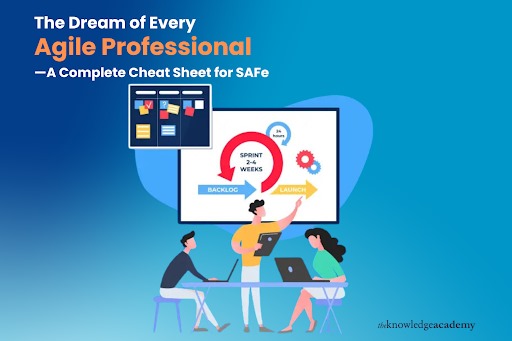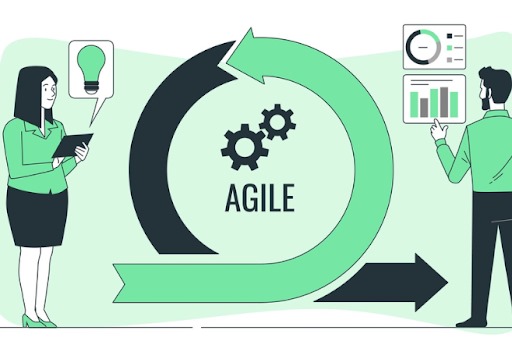Picture this: every Agile expert clutching a Scaled Agile Framework Cheat Sheet so potent it transforms organizational chaos into a symphony of streamlined processes. Sounds like a far-fetched dream? Not anymore! This cheat sheet will become your best friend regardless of your level of Agile knowledge—whether fresh on the scene or a seasoned veteran. Let’s unpack this cheat sheet that promises to demystify SAFe as you start your Agile Training path, ensuring that your Agile practices are not only functional but also quite spectacularly effective.

Table of Contents
Unpacking SAFe
SAFe, or Scaled Agile Framework, is essentially a road map for scaling Agile across larger enterprises. It’s not only about increasing team efficiency; it’s also about aligning teams across multiple departments and services to ensure the business moves as one cohesive unit. Consider SAFe as the conductor of an orchestra; every member understands when and what to perform precisely to produce harmony.
Essential Elements of a SAFe
The main components of this cheat sheet are meant to provide fast, straightforward guidance in line with SAFe principles, thereby guaranteeing that everyone’s on the same page.
Vision and Strategy Alignment
In SAFe, alignment is the keyword. Your cheat sheet should start with methods for aligning the team’s daily work with the company’s broader vision and strategic goals. This might include templates for setting objectives, defining roles, and visualizing work processes. A good tip? Use roadmaps, Gantt charts, or other big-picture visual tools; they offer more than just decorations.
Roles and Responsibilities
The first page of your cheat sheet should clearly outline the roles and obligations within a SAFe environment. From the Product Owner to the Release Train Engineer, everyone should know their parts. This clarity prevents the all-too-common project pitfall where everyone thinks someone else is handling the task.
PI Planning
An indispensable event on the SAFe calendar is programme increment (PI) planning. Your cheat sheet should serve as an in-depth guide on conducting successful PI planning sessions. Include checklists for pre-PI planning activities, tips for facilitating the event, and strategies for post-PI follow-ups. Remember, a successful PI planning session can make or break your Agile release train.
Agile Release Train (ART)
The ART is at the heart of SAFe, and understanding how to keep this train chugging along is crucial. Your cheat sheet should include insights on how to form an ART, manage its backlog, and ensure continuous delivery. It’s all about keeping the momentum without derailing the project’s goals.
Lean-Agile Principles
Twin pillars of SAFe are lean thinking and Agile development. Your cheat sheet should condense these ideas into easily referable, consumable, actionable bits. From reducing waste to empowering teams, these ideas will guide decisions across the board.
Continuous Integration and Deployment
Agile teams in a SAFe environment are dependent on CI/CD and must master these competencies. Include tips and strategies for setting up a CI/CD pipeline that works in tandem with SAFe practices. This could cover everything from automated testing protocols to integration schedules that keep the release train on track without causing disruptions to ongoing work.
Implementing the Cheat Sheet
Here’s how you can make sure the cheat sheet becomes an integral part of your team’s workflow that greatly helps in the success of your project.
Training and Workshops
No cheat sheet is effective unless the team knows how to use it. Think of organising interactive seminars or training courses where the cheat sheet is used in real-life scenarios. This interactive technique guarantees that the cheat sheet becomes more than just a documentation and actually helps cement the SAFe concepts.
Continuous Improvement
Agile’s beauty—and SAFe’s by extension—is found in its emphasis on continuous improvement. A section of your cheat sheet should focus on collecting feedback and using them to tweak processes. After all, every project is a learning opportunity, and what better way to learn than through direct feedback?

Monitoring and Metrics
Including a section on Key Performance Indicators (KPIs) and metrics that matter can help you truly leverage your SAFe cheat sheet. Specify which routinely monitored metrics teams should keep an eye on to make sure they are headed towards achieving their objectives. This could include lead time, process cycle efficiency, or program predictability measures, providing a quantifiable way to track progress and areas for improvement.
Conclusion
Creating a Scaled Agile Framework cheat sheet is about grasping the essence of SAFe and how it may be carefully integrated into the fabric of your company. This handy sheet helps you to thrive, lead, and transform Agile rather than merely survive in it. So go forth and let this cheat sheet guide your Agile journey to new heights!
For more information, visit The Knowledge Academy!
- About the Author
- Latest Posts
Whether she is researching the latest trends in home decor, life-changing destination getaways, or the best way to maintain your finances, Dewey takes pride in leaving no stone unturned. She is passionate about distilling and delivering high-quality information that you can use to upgrade your life.




